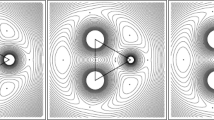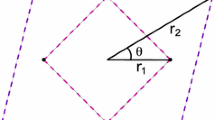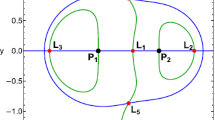Abstract
This article determines all possible (proper as well as pseudo) equilibrium arrangements under a repulsive power law force of three point particles on the unit circle. These are the critical points of the sum over the three (standardized) Riesz pair interaction terms, each given by \(V_s(r)= s^{-1}\left( r^{-s}-1 \right) \) when the real parameter \(s \ne 0\), and by \(V_0(r) := \lim _{s\rightarrow 0}V_s(r) = -\ln r\); here, r is the chordal distance between the particles in the pair. The bifurcation diagram which exhibits all these equilibrium arrangements together as functions of s features three obvious “universal” equilibria, which do not depend on s, and two not-so-obvious continuous families of s-dependent non-universal isosceles triangular equilibria. The two continuous families of non-universal equilibria are disconnected, yet they bifurcate off of a common universal limiting equilibrium (the equilateral triangular configuration), at \(s=-4\), where the graph of the total Riesz energy of the 3-particle configurations has the shape of a “monkey saddle.” In addition, one of the families of non-universal equilibria also bifurcates off of another universal equilibrium (the antipodal arrangement), at \(s=-2\). While the bifurcation at \(s=-4\) is analytical, the one at \(s=-2\) is not. The bifurcation analysis presented here is intended to serve as template for the treatment of similar N-point equilibrium problems on \({\mathbb {S}}^d\) for small N.









Similar content being viewed by others
Notes
The discontinuous jumps of \(R_s(r)\) at \(s=0\) cause some artificial difficulties when trying to compare optimal energies at negative, zero, and positive s values. This can be rectified by introducing an s-continuous “standardized Riesz s-energy” \(V_s(r)\), see below.
Some of these references use the definition \(R_s(r)=r^{-s}\) for \(s\ne 0\), and \(R_0(r)=-\ln r\) for \(s=0\), e.g. [21]. By an “optimal energy configuration” one then means a configuration which minimizes the configurational Riesz s-energy when \(s\ge 0\), or maximizes it when \(s < 0\). The historical origin of ignoring the \(\mathrm {sign}\,(s)\)-factor in front of \(r^{-s}\), which entails that one searches for the “maximum energy configuration” when \(s<0\) instead of the conventional “minimum,” seems to be that for \(s=-1\) the problem is identical to the maximal average pairwise distance problem, cf. [3, 13, 25]. Yet, having to constantly distinguish between energy minimization for \(s\ge 0\) and energy maximization for \(s<0\) in a physics-inspired narrative (i.e.: optimal “energy”) is somewhat awkward. Incidentally, the physics origin of these optimal-energy problems seems to go back to a pre-quantum mechanics inquiry into the structure of atoms by Thomson [26]. Thomson studied, among other things, the minimum energy configurations on the circle \({\mathbb {S}}^1\) of N point electrons with Coulomb’s electric pair interactions (the case \(s=1\) in \(R_s(r)\)), and he made a brief remark that similar questions can be asked for N point electrons on the sphere \({\mathbb {S}}^2\). The 1 / r problem on \({\mathbb {S}}^2\) was later dubbed “Thomson problem” by Whyte [27], and the same problem with 1 / r replaced by \(R_s(r)\) is sometimes called “the generalized Thomson problem.”
We will generally speak of particle arrangements on the unit circle because “degenerate configurations” are not configurations in the proper sense.
And, of course, it is meaningless to ask for a minimum Riesz pair energy configuration when \(N=1\), since one cannot form a pair with a single particle alone.
Incidentally, there is a slip of pen at the pertinent place in Appendix 1 of [18]: “the only equilibrium arrangements” should read “the only stable equilibrium arrangements.”
We remark (see Appendix 3 in [18]) that \(s\mapsto V_s(r)\) is a continuous, monotonically increasing function for all \(r>0\), strictly so if \(r\ne 1\), and \(V_s(1)\equiv 0\) for all s.
We remark that the degenerate linear configurations on \({\mathbb {S}}^1\) with one particle at one end point and two at the other end point of a secant which is not a diameter are not degenerate limits of proper isosceles triangular configurations on \({\mathbb {S}}^1\). While the antipodal arrangement is represented by \((\alpha ,\beta ,\gamma )=(\pi /2,\pi /2,0)\) (up to permutation), a linear but non-antipodal arrangement is the limit of a family of non-isosceles proper triangles with corners on \({\mathbb {S}}^1\) which leads to a representation \((\alpha ,\beta ,\gamma )=(\alpha ,\pi -\alpha ,0)\) (up to permutation), with \(\alpha \ne \pi /2\).
Of course, to literally plot this graph in a cartesian diagram we would need four space dimensions, which we cannot “see” simultaneously. However, one could visualize this graph as a two-dimensional surface over a two-dimensional planar equilateral triangular domain embedded in three dimensions by using the (1, 1, 1) direction as the axis for \(\langle V_s\rangle (\alpha ,\beta ,\gamma )\).
Note that “links” and “rechts” are mixed up in the caption to Fig. 21 of [1].
Of course, for \(N=2\) the antipodal configuration is trivially the absolute Riesz s-energy minimizer, but in this case, and only in this case, it is not a degenerate configuration.
For \(-2\le s\le 0\) the optimal height of the square-pyramidal configuration is constant, equal to 5 / 4. The optimized height depends on s only for \(s>0\).
References
Andersson, S.: Eine Beschreibung komplexer anorganischer Kristallstrukturen. Angew. Chem. 95, 67–80 (1983)
Atiyah, M., Sutcliffe, P.: Polyhedra in physics, chemistry, and geometry. Milan J. Math. 71, 33–58 (2003)
Beck, J.: Sums of distances between points on a sphere—an application of the theory of irregularities of distribution to discrete geometry. Mathematica 31, 33–41 (1984)
Berman, J., Hanes, K.: Optimizing the arrangement of points on the unit sphere. Math. Comp. 31, 1006–1008 (1977)
Bétermin, L., Sandier, E.: Renormalized energy and asymptotic expansion of optimal logarithmic energy on the sphere. Constr. Approx. 47, 39–74 (2018). https://doi.org/10.1007/s00365-016-9357-z
Björck, G.: Distributions of positive mass, which maximize a certain generalized energy integral. Ark. Mat. 3, 255–269 (1956)
Bowick, M.J., Cecka, C., Middleton, A.: http://thomson.phy.syr.edu/. Accessed 17 Jan 2019
Brauchart, J.S., Hardin, D.P., Saff, E.B.: The next-order term for optimal Riesz and logarithmic energy asymptotics on the sphere. In: Arvesú, J., ópez Lagomasino, G.L (eds.) Recent Advances in Orthogonal Polynomials, Special Functions, and Their Applications, Contemporary Mathematics, 578, pp. 31–61 AMS, Providence (2012)
Cohn, H., Kumar, A.: Universally optimal distribution of points on spheres. J. Am. Math. Soc. 20(1), 99–148 (2007)
Dragnev, P.D., Legg, D.A., Townsend, D.W.: Discrete logarithmic energy on the sphere. Pacific J. Math. 207(2), 345–358 (2002)
Erber, T., Hockney, G.M.: Complex systems: equilibrium configurations of \(N\) equal charges on a sphere \((2\le N\le 112)\), pp. 495–594 in Adv. Chem. Phys.XCVIII (I. Prigogine, S. A. Rice, Eds.). Wiley, New York (1997)
Fekete, M.: Über die Verteilung der Wurzeln bei gewissen algebraischen Gleichungen mit ganzzahligen Koeffizienten. Math. Z. 17, 228–249 (1923)
Fejes Tóth, L.: On the sum of distances determined by a point set. Acta. Math. Acad. Sci. Hung. 7, 397–401 (1956)
Hardin, D.P., Saff, E.B.: Discretizing manifolds via minimum energy points. Not. AMS 51, 1186–1194 (2004)
Hilbert, D., Cohn-Vossen, S.: Geometry and the Imagination, 2nd edn. Chelsea, New York (1952)
Hou, X., Shao, J.: Spherical distribution of 5 points with maximal distance sum. Discrete Comput. Geom. 46(1), 156–174 (2011)
Melnyk, T.W., Knop, O., Smith, W.R.: Extremal arrangements of points and unit charges on a sphere: equilibrium configurations revisited. Canad. J. Chem. 55(10), 1745–1761 (1977)
Nerattini, R., Brauchart, J.S., Kiessling, M.K.-H.: Optimal \(N\)-point configurations on the sphere: “Magic” numbers and Smale’s 7th problem. J. Stat. Phys. 157, 1138–1206 (2014)
Rakhmanov, E.A., Saff, E.B., Zhou, Y.M.: Minimal discrete energy on the sphere. Math. Res. Lett. 1, 647–662 (1994)
Rakhmanov, E.A., Saff, E.B., Zhou, Y.M.: Electrons on the sphere. In: Ali, R.M., Ruscheweyh, S., Saff, E.B. (eds.) Computational Methods and Function Theory, pp. 111–127. World Scientific, Singapore (1995)
Saff, E.B., Kuijlaars, A.B.J.: Distributing many points on a sphere. Math. Intell. 19, 5–11 (1997)
Sattinger, D.H.: Bifurcation and symmetrybreaking in applied mathematics. Bull. Am. Math. Soc. 3, 779–819 (1980)
Schwartz, R.E.: The Phase Transition in 5 Point Energy Minimization, (eprint) arXiv:1610.03303v3 [math.OC]
Smale, S.: Mathematical problems for the next century. Math. Intell. 20, 7–15 (1998). see also version 2 on Steve Smale’s home page: http://math.berkeley.edu/~smale/
Stolarsky, K.B.: Spherical distributions of \(N\) points with maximal distance sums are well spaced. Proc. Am. Math. Soc. 48, 203–206 (1975)
Thomson, J.J.: On the structure of the atom: an investigation of the stability and periods of oscillation of a number of corpuscles arranged at equal intervals around the circumference of a circle; with application of the results to the theory of atomic structure. Philos. Mag. 7, 237–265 (1904)
Whyte, L.L.: Unique arrangements of points on a sphere. Am. Math. Mon. 59, 606–611 (1952)
Womersley, R.S.: Robert Womersley’s home page. http://web.maths.unsw.edu.au/~rsw/
Acknowledgements
We thank Johann Brauchart for [1] and his comments, and Bernd Kawohl for the history of the book by Hilbert & Cohn-Vossen. We also thank the referee for constructive criticism.
Author information
Authors and Affiliations
Corresponding author
Additional information
Publisher's Note
Springer Nature remains neutral with regard to jurisdictional claims in published maps and institutional affiliations.
Rights and permissions
About this article
Cite this article
Kiessling, M.K.H., Yi, R. Hilbert’s ‘Monkey Saddle’ and Other Curiosities in the Equilibrium Problem of Three Point Particles on a Circle for Repulsive Power Law Forces. J Dyn Diff Equat 32, 233–256 (2020). https://doi.org/10.1007/s10884-019-09729-2
Received:
Revised:
Published:
Issue Date:
DOI: https://doi.org/10.1007/s10884-019-09729-2




